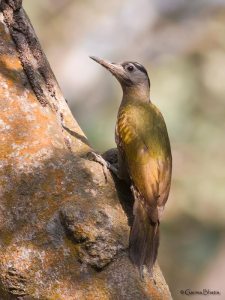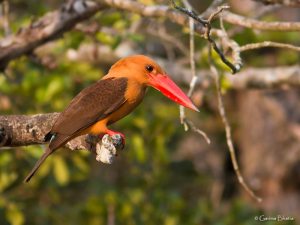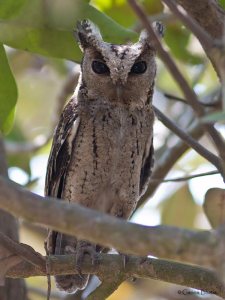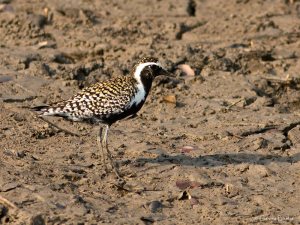The jewel of the mangroves had been luring me since last year to make a visit to Bhitarkanika, a small mangrove sanctuary in coastal Orissa. The name itself had a lyrical ring about it – “bhitar” = interior and “kanika” = gold, and conjured up an image of a lush paradise with a hint of mystery and adventure. And so it was that 4 of us set out for a rendezvous with the Mangrove Pitta, a rare beauty that was resident at Bhitarkanika and was said to be ridiculously easy to see there. The only catch – we had to brave the summer heat of April as it was most active in this season.
The motley crew assembled at Bhubaneshwar one scorching afternoon – Rajneesh and me from Bangalore, my dad flew from Chennai, and the final member, Dr Abhinav from Himachal for whom it was to be the first birding trip south of UP. We had a few hours to wait before his arrival, which were effectively utilised in sampling the culinary specialities of the town – from Lingaraj Lassi to a sumptuous Oriya thali at Dalma. Dessert was had after picking up Abhinav from the airport, at a town called Pahala en route to Cuttack, which boasted of hundreds of rasgulla shops lining the highway. Orissa claimed to be the birthplace of the rasgulla, and the soft spongy samples we consumed did not disappoint.
Thus sated, we continued with the long drive to Dangmal village, where the forest dept had set up a tourist complex, with accommodation facilities as well as boating and walking trails through the mangroves. En route, we made some birding stops in the intense heat, picking off some easy birds for the doctor, who nearly jumped out of the car every time a lifer was mentioned. In fits and starts we took more than 5 hours to cover the distance of hardly 200 km (road conditions didn’t help) and reached Bhitarkanika well after dark. (On the way we passed by Garhimatha sanctuary, famous for the mass nesting of Olive Ridley turtles each year.) At Dangmal we were promptly informed by our guide that crocs like to frequent the grounds of the tourist complex at night, and we should be careful. At the rooms we were welcomed by a calling Large-tailed Nightjar, and a healthy population of mosquitos, and after an early dinner, were ready to hit the sack.
Next morning we were up bright eyed and bushy tailed, and were to spend the time along the mangrove trails on foot. En route from our cottage to the trail we encountered a great number of woodpeckers – Black-rumped Flameback, Greater Flameback, Rufous Woodpecker and Grey-headed Woodpecker, besides Brown-winged and Collared Kingfishers. Near the jetty, the loud call of Mangrove Pitta was heard and we found the singer in a tree right next to the road!
Along the trail, several more pittas were seen and photographed as they went about displaying and staking claim to their territory. Several were paired up already and it was a treat to watch these beauties hopping about unconcerned and undisturbed by our presence. As the heat built up, we headed back to our breakfast, following which some brave souls decided to try their photography luck in the relentless heat.
We had planned for a boat ride in the creek in the afternoon, and set out at 4pm once the heat had reduced a bit. The ride yielded numerous salt water crocodiles of varying ages and sizes – these were the most famous residents of Bhitarkanika which the tourists came to see. We also encountered several waders, many in breeding plumage – including Pacific Golden Plovers, Lesser Sand Plovers and Common Redshanks. Other highlights were 5 sightings of Slaty-breasted Rail, a lone Ruddy-breasted Crake and a Lesser Adjutant. Brown-winged Kingfishers were very confiding and offered very close approach, but Collared Kingfishers were not so cooperative. A Brown-winged Kingfisher was seen chasing a Mangrove Pitta, a fantastically colourful sight!
In one day, the lifer list of the Himachali resident had already well exceeded his expected number, but he was determined to make use of every moment of daylight productively. The next morning after a desultory boat ride in which no new species were added to the list, we set out birding on the trail. The resident Scops Owl (Collared, though Oriental was also seen) was seen inside a clump of trees near the jetty, and was the focus of much attention, from us and another group which had arrived that morning. (The group was fully outfitted from head to toe in camo gear when we left for the boat ride, but by the time we returned in the heat at least one of them had given up on the effort and stripped down to his white undershirt!)
After breakfast we decided to try our luck with some pittas, and soon enough had a close encounter with a pair nonchalantly feeding along the edge of the mangrove trail. I called it quits soon after, opting to retire to the shelter of the guest house and the luxury of a fan, but the others continued to seek better photographs valiantly. The good doctor was especially persistent. Lugging a camera more than half his size, we worried that he would get heat stroke, unused as he was to the heat and humidity of the plains. But he returned triumphantly just before lunch displaying stunning photographs of a Mangrove Pitta eating a crab.
The boat ride post lunch and next morning’s birding brought a few more coveted lifers to the doctor and soon it was time to head back to Bhubaneswar. En route an impromptu stop at a sweet shop of the famous Bikali Kar (legendary sweets maker of Orissa), in his home town of Salepur, where we consumed singhadas (the East’s version of samosa) par excellence and gigantic kheermohan (rasgulla with caramelised sugar). At Bhubaneswar we met up with Panchami, who treated us to an exquisite oriya meal at a restaurant at hotel mayfair, over stories about a nesting colony of skimmers, providing a fitting close to a productive birding trip.
Thanks to Wayfarer for organizing the trip. Here are some more images from Bhitarkanika:






Pingback: Jewel of the Mangroves – Fundamatics